When a cycling city like Bremen, with a cycling modal share of 25%, announces its flagship cycling infrastructure initiative of this parliament, you would expect at least some bold and innovative measures. The name of the flagship policy – Premium Routes – certainly trumpets the idea that these will be even better than the existing, substantial, cycling network.
Details of the first such route, a 43.8km long stretch from Farge in the north-west of Bremen to Mahndorf in the southeast, were announced this week. The headlines made good reading, but the devil is in the detail. Transport Senator Joachim Lohse presented the feasibility study for this route on Wednesday:
- 53% of the route will be on Bremen-style Cycle Streets, in which motor traffic will freely mix with cyclists. Regular readers will be aware of how poor the Bremen Cycle Street model really is.
- A further 4% will be on normal 50 km/h roads. Thus 57% of the route will involve mixing cyclists with cars.
- 3% will involve on-road cycle lanes.
- 30% will be on 2-way cycle tracks, most of which will be on the roadside.
- 7% will be on 1-way cycle tracks.
- 3% will be on shared foot and cycle paths.
Premium Routes will inevitably involve some compromises along the way. This, for example, is a Premium Route in Venlo in the Netherlands.
But to call a cycle route “Premium” when 60% of it is on-road? The hallmark of Copenhagen’s progress in developing its cycle network – the re-purposing of whole motor traffic lanes as separated cycleways – is almost completely absent from the plans. We found just one example, at the corner of two streets, Herdentorsteinweg and Am Wall (on pages 117ff of the study). The refurbishing and broadening of existing, separated cycleways – the real backbone of the cycle network in Bremen – occurs only sporadically, on Steffensweg in Walle and part of the Osterdeich in the eastern suburbs.
Consultants’ Sticking Points
The consultants themselves point to a number of problems (known in the jargon as “points with increased clarification requirements”) on the last pages of their study (p. 147f), here only an excerpt:
- “Using Cycle Streets on the Premium Route with regard to the normal regulations and in connection with 30km/h zones (More than 50% of the routes are on Cycle Streets)”. The question is how the priority of the Cycle Street, for each crossing side street, can be effectively marked (p.23ff). This issue was addressed in a different way on slide 79 of an earlier version of the feasibility study: “using Cycle Streets on the premium route (if the technical prerequisites do not yet exist)“. The consultants themselves express doubts about the wide use of Cycle Streets on a Premium Route.
- “Enforceability of the regulations for parking in residential streets”. Surely the enforcement of parking bans on a Premium Route would be a matter of course? Are trunk roads in cities not routinely cleared of illegally parked cars?
- “Lange Reihe has too high a car volume for a bicycle road; removing cobblestones for new asphalt.” The latter is very expensive. € 1.2 m are to be spent on this road (Lange Reihe / Steffensweg). (Pg. 139) 5,800 motorised vehicles pass through this street every day, too many according to guidelines for a Cycle Street (maximum 4,000, see pg. 16), but this was recommended anyway because of the pressure for car parking. “As an alternative to the Cycle Street, cycle paths on both sides, or a 2-way path on one side, would avoid the need for extensive resurfacing. But this measure would also be costly because of the necessary on-board offsets. On the other hand there would be no possibility of car parking on both sides of the road, so about half of the parking space would have to be removed, which in this residential area, with high car parking demand, would be difficult to compensate with space elsewhere.” In the section to the north, on Steffensweg, the cycleway will be widened for € 600,000. If the consultants had applied the same solution to Lange Reihe, the conversion would almost certainly have cost less than €1.2m.
Thus, for the sake of car parking on Lange Reihe, the quality of the Premium Route is sacrificed. No solution is offered for the reduction of car traffic to Bremen Cycle Street standards, and additional costs are accepted – a clear subsidy of the car. Interestingly, compare this to the text on page 73 for a Cycle Street in Hemelingen: “The possibility of taking the Premium Route through Christernstrasse was discussed with the working group in May 2016 and was regarded by most participants critically. A traffic load of 2,800 cars / day as well as three bus lines in the section west of Brüggewegs makes no Premium Route standard possible.”
Some Examples
We cycled along the eastern half of the proposed route, from Osterdeich to Mahndorf railway station. Here are our observations :
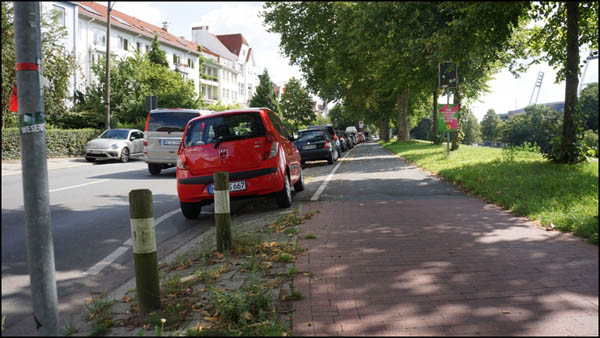 On the Osterdeich between Café Ambiente and the Weserstadion: existing width 2,50. The consultants want to have the cars parked on the road here and broaden the two-way cycle track to 3m (p.124). This meets accepted German standards, though not for a main cycle route.
On the Osterdeich between Café Ambiente and the Weserstadion: existing width 2,50. The consultants want to have the cars parked on the road here and broaden the two-way cycle track to 3m (p.124). This meets accepted German standards, though not for a main cycle route.
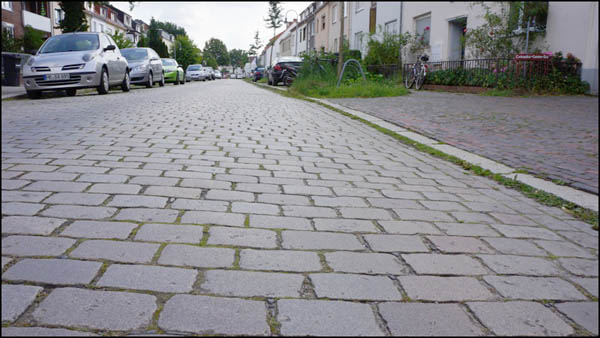 Cobblestones in Alter Postweg in Hemelingen. Uncomfortable.
Cobblestones in Alter Postweg in Hemelingen. Uncomfortable.
 Cobblestones on Ahlringstraße, near Sebaldsbrück station. Most cyclists use the pavement.
Cobblestones on Ahlringstraße, near Sebaldsbrück station. Most cyclists use the pavement.
Here is the only stretch where a completely independent, green cycle path is to be built: length 370 m, width: 4 m (feasibility study, older version p. 63)…..
 Tamra-Hemelingen-Park: shortly after Sebaldsbrück station.
Tamra-Hemelingen-Park: shortly after Sebaldsbrück station.
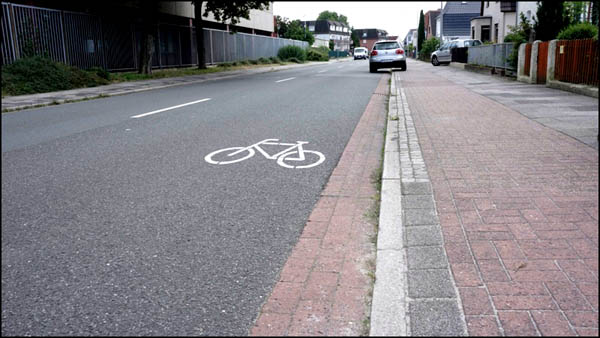 Christernstraße (east of Bruggeweg): This is to be converted into a Cycle Street, but why? There are three bus lines (40, 41, 29), and the existing cycle path is completely in order. Even the consultants have their doubts: “The possibility of leading the Premium Route through Christernstraße was discussed with the working group in May 2016 and was seen by most participants critically. A traffic load of 2,800 vehicles / day as well as three bus lines in the section west of Bruggeweg make no Premium Route standards possible. “(Feasibility Study long version, p. 73) Their suggestion: ” Because of their importance for bus services, these streets are only conditionally compatible with the idea of a Cycle Street. In this respect, the recommendation is to use the existing road, in mixed traffic, for the Premium route.”(Feasibility Study long version, p.88).
Christernstraße (east of Bruggeweg): This is to be converted into a Cycle Street, but why? There are three bus lines (40, 41, 29), and the existing cycle path is completely in order. Even the consultants have their doubts: “The possibility of leading the Premium Route through Christernstraße was discussed with the working group in May 2016 and was seen by most participants critically. A traffic load of 2,800 vehicles / day as well as three bus lines in the section west of Bruggeweg make no Premium Route standards possible. “(Feasibility Study long version, p. 73) Their suggestion: ” Because of their importance for bus services, these streets are only conditionally compatible with the idea of a Cycle Street. In this respect, the recommendation is to use the existing road, in mixed traffic, for the Premium route.”(Feasibility Study long version, p.88).
And the next problem:
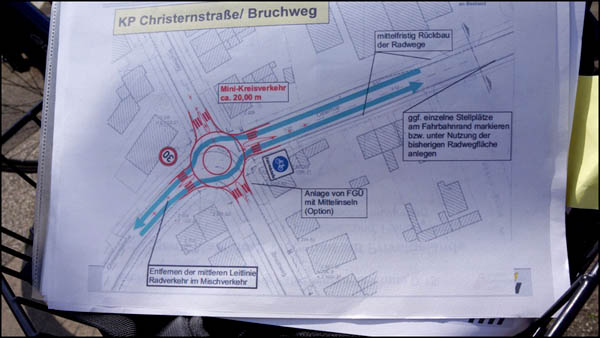 A planned mini-roundabout on the junction of Christernstraße and Bruchweg
A planned mini-roundabout on the junction of Christernstraße and Bruchweg
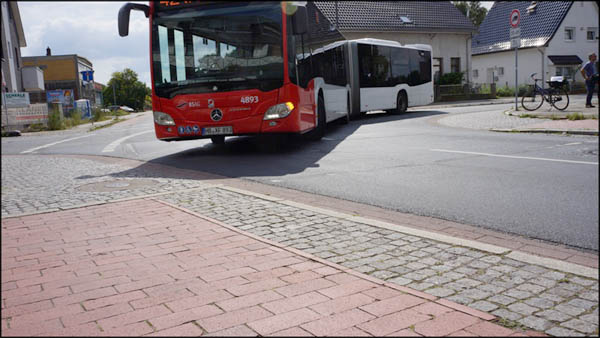 This is why. Bus turning on the junction of Christernstraße and Bruchweg. Right in front of us an intact bike path. So who would want to cycle on the road? The consultants’ opinion: “(A mini roundabout) creates a balance between the interests of cyclists and bus traffic” (Feasibility Study long version, p. 90).
This is why. Bus turning on the junction of Christernstraße and Bruchweg. Right in front of us an intact bike path. So who would want to cycle on the road? The consultants’ opinion: “(A mini roundabout) creates a balance between the interests of cyclists and bus traffic” (Feasibility Study long version, p. 90).
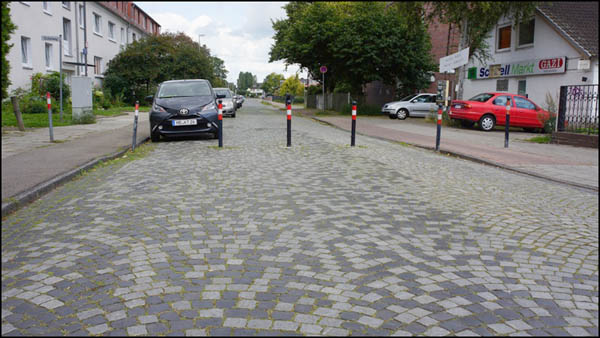 Cobblestones on Osterhop. Aha, here through traffic is interrupted. It can be done!
Cobblestones on Osterhop. Aha, here through traffic is interrupted. It can be done!
 A crossing will be needed here, on Nauheimer Straße at the corener of Harzer Straße. The route crosses to the other side in the Ortwisch, which in turn is very cyclable. But this is a likely spot where cycling commuters will be slowed.
A crossing will be needed here, on Nauheimer Straße at the corener of Harzer Straße. The route crosses to the other side in the Ortwisch, which in turn is very cyclable. But this is a likely spot where cycling commuters will be slowed.
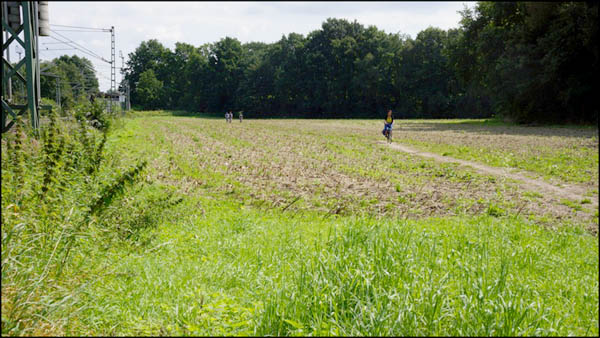 Shortly before Mahndorf railway station the cycle path peters out. It is unclear where the Premium Route will go. Along this field….
Shortly before Mahndorf railway station the cycle path peters out. It is unclear where the Premium Route will go. Along this field….
…or over this level crossing?
These are just some of the problems on this route. The high proportion of cobblestone streets, the dismantling of completely intact cycle paths on streets with bus services such as Christernstrasse, and the repeatedly suggested compromises (see, for example, Osterdeich) is striking. And what is quite astounding: 4% of the route without bike infrastructure in mixed traffic with 50 km / h, and a whopping 53% on poor standard Cycle Streets.
The consultants involved have stated clearly why this is the case:”since there is no need for major reconstruction measures when setting up such cycle routes” (page 65) Cycle routes are therefore a cheap solution”. To expect any kind of “premium” quality route on the cheap is patently ridiculous.
But there is a hint of hope: the consultants have fallen far short of the city’s original project budget with their recommendations (see p. 139). The original cost range was € 500,000 to € 1 million per kilometre. The current proposals have been costed at € 415,000 per kilometre. Theoretically, the whole project could have a budget twice as large as now recommended. There is still a lot of financial headroom to improve the route’s quality.
With so much on-road cycling, in reality this is not a Premium Route, but a route for aspiring Vehicular Cyclists, a concept that has been abandoned by successful cycling nations and cities for decades. But amongst Bremen’s administration. politicians and even advisers who should know better, it is rife. Perhaps this is due to genuine belief – there is a surprising lack of knowledge in Bremen of the various English-language debates around vehicular cycling – or expediency, as removing cycle tracks conveniently creates more space for car parking. However, pleading state poverty is certainly NOT an option here. The original budget is twice the cost of the current proposals. And digging up whole cobblestone streets rather than widening existing cycle tracks is inherently more expensive – the asphalting of Lange Reihe alone has been costed at € 1.2m . Either way, this in part explains why the bike rate has been stagnating here for more than 20 years.
Calling this proposal a Premium Route adds another term to the 1984-inspired Bremen dictionary of New-speak. If a Bremen Cycle Street is (un)good, a Bremen Premium Route is surely doubleplus(-un)good. It is then a simple job for the administration’s Press Department to remove the items in brackets and sell the idea as a good news story to the local media.
Hallo Beatrix,
danke für Deine Zusammenfassung und Analyse!
Mangels Streckenkenntnis und Lesens des kompletten Konzepts bezieht sich mein Kommentar im Wesentlichen auf den vorliegenden bremenize-Artikel.
Natürlich kann man sich bessere und größere Planungen wünschen, aber m. E. wäre eine Umsetzung der geplanten Premium-Route(n) schon mal eine Verbesserung gegenüber dem Status Quo und eine begrüßenswerte Verbesserung. Noch besser geht immer.
Zur geplanten Straßenaufteilung:
53% Fahrradstraße –> siehe unten
4 % Mischverkehr mit 50 km/h –> geht gar nicht, sehe ich genau so
3 % Schutzstreifen und Radfahrstreifen –> Schutzstreifen sind m. E. nicht premiumtauglich!
30 % Zweirichtungsradwegen –> bei 4 m okay (ggf. sogar mit Markierung für die Richtungsfahrstreifen), bei schmaler zu gefährlich und nicht premiumtauglich; alle gegenwärtigen Zwei-Richtungs-Radwege, die ich kenne, sind nicht premiumtauglich, sondern vielmehr ausgesprochen gefährlich! und wer Zweirichtungsradwege sät, wird Geisterradler ernten.
7 % auf Einrichtungsradwegen –> okay, siehe Kommentar unten
3 % gemeinsamen –> Schrittgeschwindigkeit ist auch nicht premiumtauglich
Eine Autobahn ist attraktiv, weil sie Reisezeiten verkürzt, obwohl man mitunter sogar Umwege fährt. So stelle ich mir auch einen gelungen Radschnellweg oder eine Premiumroute vor. Man kann dort so komfortabel und zügig fahren, dass es sich lohnt, extra dafür einen Schlenker zu fahren. Entscheidend dürfte dabei der Netzcharakter, die Führung an Kreuzungen etc. sein. Wenn das klappt, nimmt auf der Premiumroute der Radverkehr zu: einmal, weil Verkehr von parallen Strecken gebündelt wird und weil neuer Verkehr erzeugt wird. Und man kann ja Safety-by-Numbers so oder so sehen, aber es dürfte Einigkeit besetehen, dass man sich als Radfahrer auf Fahrradstraßen um so wohler fühlt (und wahrscheinlich auch objektiv sicherer ist), je größer dort der Radverkehrsanteil ist. Insofern sehe ich das mit den Fahrradstraßen längst nicht so kritisch wie hier angemerkt.
Zu den (Einrichtungs)-Radwegen: Nix gegen gute, separate Infrastruktur. Aber die hier im Artikel fotografierten Radwege sind m. E. auch nicht premiumtauglich: Bei einer Premiumroute erwarte ich a) viel Verkehr und b) eine heterogene Verteilung (von langsam bis schnell), so dass auch immer wieder Überholvergänge möglich sein sollten. Stichwort: Pedelecs und Anhänger/Lastenräder! Und wo die Radwege einfach nicht mehr können, ist auf der Fahrbahn noch Luft nach oben. Siehe pn.
Schön (auch im Sinne von Komfort und Attraktivität und dass man einfach gerne fährt), wären natürlich komplett separate Radwege (“im Grünen” wie der RS1), aber dem sind in einer dicht bebauten Stadt nun mal Grenzen gesetzt.
Viele Grüße
Karsten
Lieber Karsten, vielen Dank für Deinen Kommentar. Wir sind natürlich an der Stelle d’accord, dass eine Premiumroute besser als keine ist. Und wie Du sehen wir die bestehenden, vernachlässigten Radwege höchst kritisch. Aber dass an diesen Radwegen ungern was gemacht wird, hängt an dem Schlupfloch “Aufhebung der Radwegebenutzungspflicht”, das die Verwaltung sehr gerne nutzt, weil es so schön billig ist. Billig sind auch die Fahrradstraßen neuerer Art in Bremen, leider.
Und warum wir hier so kritisch mit der Planung umgehen, ist eigentlich klar, wenn Du Dir unsere Kritik an der Bremischen Version von Fahrradstraßen ansiehst. Der Erfolg (auch der Premiumroute) von Fahrradstraßen steht und fällt mit ihrem Design. Hast Du Durchgangsverkehr, ist d as Fahren einfach nicht mehr angenehm für uns RadlerInnen. Es wird von hinten gedrängelt, zu eng überholt usw.. Das ist gefährlich und macht keinen Spaß. Und wo ich nicht gerne radele, tue ich es nicht. Und genau an diesem Punkt besteht die Machbarkeitsstudie leider nicht auf die Einrichtung von echten Fahrradstraßen, sondern die GutachterInnen murkeln mit den Kompromissen weiter, die die Bremer Verwaltung insb. das ASV uns immer wieder bescheren. Ich denke, die GutachterInnen hatten entsprechende Vorgaben.
Unser Petitum ist: Wenn Ihr schon an 53% der Strecke Fahrradstraßen einrichten wollt, dann macht es endlich anständig. Am besten keine Autos, und wenn dann nur Anlieger (möglichst mit Pollern in der Mitte, damit der Durchgangsverkehr nicht durchkommt oder gegenläufigen Einbahnstraßen) und unbedingt: Überholverbot!!
Bremen vertut hier eine große Chance! Das ist so super schade.
Schöne Grüße
Beatrix